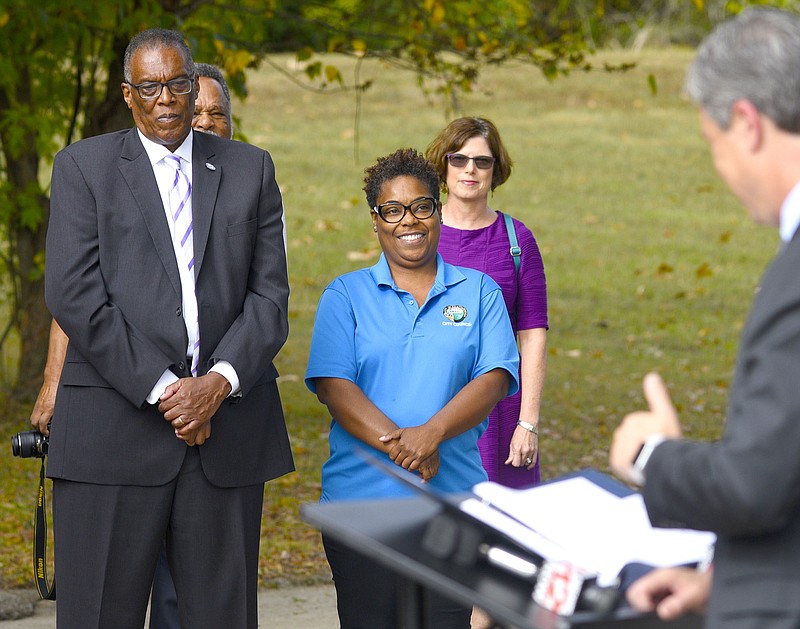Turning blighted communities around is rarely easy. If it were, we wouldn't have blighted communities.
But it's not impossible, and Chattanooga Mayor Andy Berke and Hamilton County Mayor Jim Coppinger deserve atta-boys for a proposal to put new tax dollars to work rebuilding East Chattanooga.
Those new tax dollars will be available thanks to a recently announced plan by Nippon to build an automotive paint factory on the former Harriet Tubman housing site. The Japanese company, which plans on hiring about 150 people, will be the first major new manufacturer to locate in the East Chattanooga area since 1917. Nippon wants to be there because, its leaders say, they like having a community workforce.
That is especially good news in a community where within a half-mile radius of the planned plant, the median household income of residents is less than $25,000 a year and nearly 30% of households don't have automobiles.
But neighborhood renewal is, as we mentioned, a complex beast. Jobs are a great start, but strong communities also need daycare facilities and early learning centers, grocery stores, small support and retail businesses and a growing stable of affordable housing, among other things.
That's where Berke's and Coppinger's plan to create a tax increment financing district - known as a TIF - comes in. Under a TIF, developers spend the money for a project up front, then are paid back with interest over a period of time from additional tax revenues generated by the development in the designated area. The idea is to give developers help and incentives to take a risk on a blighted community.
Billing the push as "East Chattanooga Rising," Berke and Coppinger hope to plow back some of the taxes paid by Nippon that are not automatically allocated to schools into supporting new development in the area.
"The investment by Nippon is a huge vote of confidence in this area and we hope to build upon that and use some of the resources from this investment to help develop this area in a way that aligns with what the new Area 3 plan for East Chattanooga is proposing," Berke said. "If we can get private investment on the front side of the Tubman site as well, that is truly a sign that East Chattanooga is rising."
Nippon's $61 million plant, to be built over the next two years, will sit on about 29 acres of the 45-acre former Tubman site between Sholar and Roanoke avenues. The remaining 15-16 acres will comprise the proposed TIF district.
The extra tax revenues generated by the paint factory are projected to produce more than $2.8 million over the next 20 years in additional taxes for Hamilton County public schools and more than $5 million in other payments to city and county governments, while still providing enough extra property taxes under the TIF plan to fund a 20-year bond issue of up to about $3.5 million. Those TIF funds could be used to build infrastructure and other investments to aid development in front of the Nippon plant
Berke said the city will put out a request for proposals with the goal of encouraging new retail and support development. The proposals should be compatible with what the neighborhood wants in East Chattanooga, which could include more housing, a preschool and retail development for the area.
TIFs are almost always controversial - especially here, where many see them as government tax dollars subsidizing developers who rarely need the help. Corporate welfare, if you will.
This proposed TIF would be the third created in Chattanooga and still must be approved by the Chattanooga City Council and the Hamilton County Commission.
But this one is different, in that it really would help a blighted area.
For that reason, one the staunchest opponents of TIFs in Chattanooga has given this one her blessing.
Helen Burns Sharp, a retired planner and the president of the citizens group known as Accountability for Taxpayer Money (ATM), has opposed previous TIFs for the Black Creek development in Lookout Valley and the extension of West M.L. King Boulevard to new riverfront development in downtown's Westside. But she praises this one as an example of how such tax-funded redevelopment projects should be structured to help economically challenged parts of the city.
"This TIF would be different in that this neighborhood meets the blight test," Sharp said Wednesday. "TIF can be a catalyst for development that likely would not happen without the incentive."
Ken Smith, president of the Avondale Neighborhood Association, also likes it and calls it "the icing on the cake" to rebuild the community - especially following on the city's recent additions of the Avondale Youth and Family Center and improvements to the Wilcox tunnel and sidewalks along Glass Street.
Sure there are a few loud detractors - Marie Mott, for one, who criticized the city for lack of transparency in recruiting the company so more community people could have been training for jobs. Mott has said she plans in 2021 to challenge the incumbent council member in District 8.
We agree with Sharp that this is an admirable use of our tax dollars. And, like Sharp, we look forward to our city and county leaders working with neighborhood residents to get more of their help and input in shaping the plan for the site and neighborhood.
